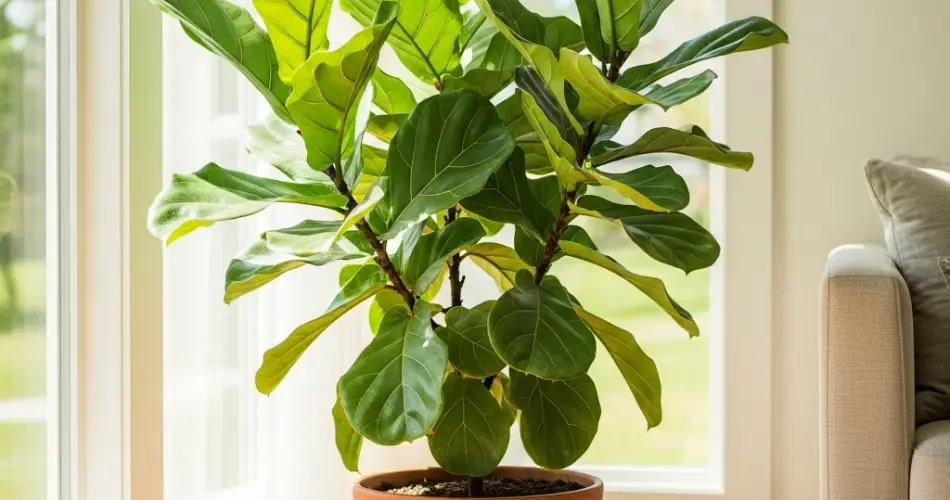Fiddle Leaf Fig (Ficus lyrata) plants are known for their striking, sculptural leaves and tall growth. However, when those glossy green leaves start to droop or turn brown, it’s a clear sign something is off. Understanding the root cause of the issue is essential to restoring your plant’s health. Droopy or brown leaves can result from a variety of problems—ranging from improper watering to environmental stress.
Here’s how to diagnose and fix the most common causes of droopy or browning fiddle leaf fig leaves.
1. Underwatering
One of the most common reasons for droopy leaves is underwatering. When a fiddle leaf fig doesn’t get enough water, it starts to conserve moisture by drooping its leaves. The soil may appear dry and even cracked, and the leaves may feel crispy around the edges.
What to do:
Water the plant thoroughly until water runs out of the drainage holes. Going forward, check the soil regularly. Water again when the top 1–2 inches of soil feel dry. Avoid waiting until the leaves droop before watering—it’s better to keep the moisture consistent.
2. Overwatering and Poor Drainage
On the flip side, too much water can be just as harmful. Overwatering causes root rot, which prevents the roots from absorbing water properly—even though the soil is wet. This results in drooping, yellowing, or browning leaves, especially near the base of the plant.
What to do:
Check for signs of root rot: foul smell from the soil, mushy roots, or soggy soil. Remove the plant from the pot and inspect the roots. Trim off any black, mushy roots, then repot the plant in fresh, well-draining soil. Always use a pot with drainage holes, and never let the plant sit in standing water.
3. Inconsistent Watering
Fiddle leaf figs prefer a steady watering schedule. Allowing the plant to dry out completely, then overcompensating with a heavy watering, can cause stress. This rollercoaster effect often leads to brown spots, leaf drop, or drooping leaves.
What to do:
Stick to a regular watering schedule. Use a moisture meter or your finger to gauge when the top inch or two of soil is dry. Consistency is key to preventing stress.
4. Low Humidity
Native to humid tropical climates, fiddle leaf figs may struggle in dry indoor air. Low humidity can cause brown edges or tips on the leaves, especially during winter when heaters are running.
What to do:
Increase humidity by misting the leaves, placing a tray of water and pebbles beneath the pot, or using a room humidifier. Grouping plants together can also help raise local humidity levels.
5. Light Stress
Too little light can weaken the plant and cause the leaves to droop, while too much direct sunlight can scorch them, causing brown spots or crispy edges.
What to do:
Place your fiddle leaf fig in a spot with bright, indirect light. A few hours of gentle morning sun is fine, but avoid intense afternoon rays. If the plant is too far from a window, consider using a grow light.
6. Temperature Fluctuations
Sudden temperature changes, drafts, or heat from radiators can shock fiddle leaf figs. These conditions often lead to leaf droop or brown spots.
What to do:
Keep your plant in a stable environment away from vents, open windows, and radiators. The ideal temperature range is between 65°F to 75°F (18°C to 24°C).
7. Pest Infestation
Spider mites, mealybugs, and scale can weaken the plant, leading to droopy or discolored leaves. Check the underside of the leaves and along the stems for tiny bugs or webbing.
What to do:
Remove visible pests by wiping the leaves with a damp cloth. Use insecticidal soap or neem oil as needed. Keep the plant isolated from others until the issue is resolved.
8. Natural Aging
Sometimes, older leaves naturally turn brown and fall off. If the browning is limited to the oldest leaves near the bottom, and the rest of the plant looks healthy, there may be no cause for concern.
What to do:
Simply prune the dying leaves. Focus on supporting the plant’s overall health with good care.
Final Thoughts
Droopy or brown leaves on a fiddle leaf fig don’t mean it’s doomed. They’re your plant’s way of signaling that something needs to change. By identifying the cause—whether it’s watering issues, light stress, pests, or humidity—you can take the right steps to fix the problem. With the proper care, your fiddle leaf fig will perk back up and continue to thrive.



